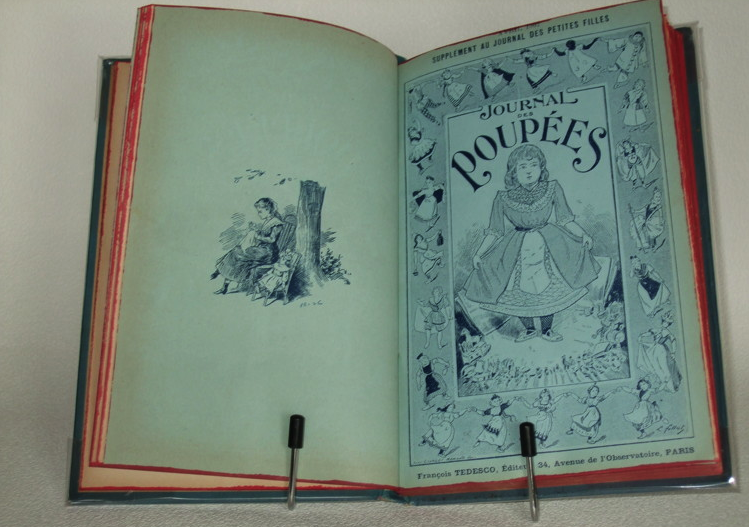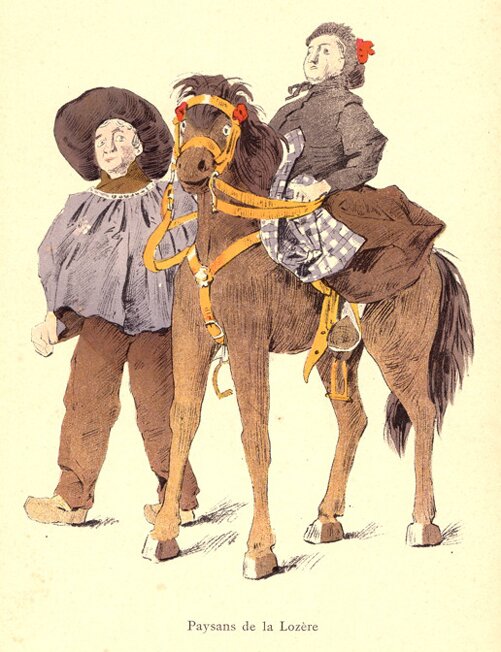
 |
|
Miss Marie Koenig and her exceptional Museum of Provincial Dolls continues to interest you. The site which we already dedicated them several years ago is always very visited. ( koeniggb.html ) We are very happy there … Especially since we are going to be able to complete it.We found at our young favorite bookseller's of Normandy a small blue entitled book " Newspaper of dolls " " Organ of the SOCIETY OF DOLLS " |
 |
|
In fact all year bound of 1902 of the supplement to the " Journal des Petites Filles " (newspaper of the Little Girls), itself stemming from the Poupée Modèle. Each of them contains 16 pages of diverse and charming readings more the first one and thé last one is pale blue paper cover. It is not thus a simple small leaflet but a real small newspaper published by Tedesco. This book binds naturally twelve numbers of the " Journal des Poupees " and begins in January; but our interest concerned at once to the number of April which begins by : A reception at the Museum of Dolls |
 |
|
And begin with the journey of Çoisice from Plougastel for Paris, street Gay-Lussac, direction Miss Marie Koenig's museum. Dressed in bridal suit, this one very detailed, is minutely described: " At first, the " dalen " ( headband) " because our hairstyle would not be authentic and the visitors who know there would notice it ". Over this one, one " dalleden " ( white linen) to which we shall adapt one " bourdelen ", ( wooden! or zinc piece ), intended to support the bottom of the headgear. On this building, we put the bonnet of the country, very simple, it is a wide banner ended with two legs which get up in wings and become attached by a pin at the bottom of the headgear.
Here is summarized, the bride and her headgear. Then appears the little Fadette who recites to a " Sablaise ", fisherwoman, her known song " Fadet, Fadet, my young fadet....".In the continuation of article, she finds "one's home man" the player of bagpipes, Yves, who presents Vivette, a lovely young lady from Arles who began singing " O. Magali ma tant amado ...," dressed in her "ease" (blouse) of black sheet, her "Capello" of wrinkled tulle and her "mireille " (white tie knoted on the bun) |
 |
 |
| Then arrives the portrait and even Marie - Amélie's photo (this one has the same name as the French queen of time). This photo is regrettably unexploitable, too much watered down. Miss Marie Koenig tells her story to the visitors of the Museum who stop to contemplate her because she has a shop window for her only.. Follows then a delicious playlet which stages the farmer of Saint-Acheul, Melita, who is a "hortillon" in small Venice formed by twelve arms of the Somme river enclosing numerous maraichers gardens . " … We consume a lot of coffee which protect us from fevers … The pass of my hat is called " le papillon ( the butterfly)" ;... it exceeds hair on the forehead and disappears on each side under the bun to form on the nape of the neck a big knot. My scarf is in green lawn lined with a straw-colored ribbon, weaved in the material, on which a garland of fairy roses. My dress is in red sheet and my apron in black taffeta. " |
 |
The conversation continues with the Boulonnaise, Chèrie: " ...To sell my fish, I do not wear this magnificent hat spread(displayed) in a halo as the tail of a peacock; I content myself with a small headgear in thick material with flat pass. We sell the fish of our fishermen by means of a rope spent in the front of the breast, we concern loads on thé back. But on Sundays, we put our most beautiful attires: underskirt of lined(crossed off) flannelette, skirt of red sheet, casaquin stocked with velvet, long drop earrings, and our delicious cap which we fix to the head with pins with big golden ball.
Then the speakingtime is to the mâconnaise, Claudette: " I, it is my hat which makes all my originality. Curious and rare, today bressanes and mâconnaises do not wear any more this singular hat because it is horribly heavy. Furthermore, as it leans on a single point of the head, it brings a premature baldness (!) which made it abandon; our grandmothers preserve their hat affectedly, there is whist cost up to one thousand and fifteen hundred francs because of thematchings and jewels with which they were decorated. My more elegant dress is velvet garnet stocked with stripes of white silver satin, my cuffs) covered with black lace; my apron is silk green and my ruffle is furnished with true Valenciennes. "
|
 |
| Finally comes on stage the girl Fadette, known to be the girl of an old lady who was supposed to be for the witch of the village and took care not many of the aspect of the child which danced nevertheless faggots with Audry, the day of Saint Antioche. On the wise advice of this one, she put a little order in her dress and her presentation, and all this ended by a marriage All these delicious conversations took place in the Miss Marie Koenig's office that they had found the means to invest but that they had to leave stealthily because of knocks at the door this one. They returned to the Museum wisely and discreetly. |
 |
 |
| A couple, a husband and a woman, shepherds of the Valley of Bethmale appear then. " We are best dresse up (!) by the place. My Jeannette, with her white cornet and her embroidered red capulet, her skirt wrinkled , her jacket with short sleeves and her scarf to réal drawings, has better air than many dolls which I do not want to name … but the show is so new as I do not grow tired of looking at it : men farmers, women farmervin largest number " There is there good God !. " I find companions who speak about their village. There is in particular a shepherd of the valley of Osseaux to the whom try to fool me because is costume, quite woolen, is rather elegant and because he has especially, a pair of gaiters with bouffettes in the knees which make him very proud but my clogs decorated with yellow nails feigning on the upper, with hearts and flowers, are as well pretty, otherwise more that his. " |
 |
| The husband of this couple, very sure of him, also gets acquainted of a villager of Salvetat: " Oh! That one is funny with the sarrau in canvas, his " ragas " (pants) were buttoned on the side up to knees. He has the curly hair which fall on the neck and a big wide-brimmed felt hat. But the one with who I get on tell is a small farmer from Vosges sharp, as happy as a lark and cunning as possible " " After all, our fate deserves envy; we are accommodated, maintained and dressed it the expense of the State; we are not any more obliged to make hard work to eat; our existence is insured; we have a good manager-woman who protects us from moths and from worms; It does not miss dolls which would indeed like to be on our place.." |
 |
| Little by little the darkness invades the room, dolls reinstated all their shop windows; Çoisic took back the place which Miss Koenig had assigned her and at dead of night, chatted with a farmer's wife of Loudéac who told her that in her country, the women always have in the arm one limps with tin as the botanists carry it; when it is too much blowing and when the headgear threatens to fly away, they place it in this limp; the same farmer still taught her that annoter one lie her do not miss their umbrella. It is provided in the extremity, of a big ring which they spend in the arm as a bracelet; even by dancing, they keep there umbrella … |
| But, four hours rang, Miss Koenig, her hat on the head, walked past all the shop windows to make sure that all her small world was on its place, she beholds the big room of a circular glance and " cric, crac ", the key turned in the lock, dolls were prisoners and…… free ! ------------------------------------------ The dolls have taken their place and seem very wise. Their quiet little tune does not assume their trip and their chatter. But as Poupendol you were certainly very happy to listen and to learn from their mouths these dress costumes precisions on our beautiful provinces. |
| Hélène BUGAT-PUJOL |
| Post-Scriptm The Dolls Museum was set up by Miss Marie Koenig in 1890 (as part of the permanent exhibition of needlework), within the Educational Museum founded in 1879 by Jules Ferry. An Album probably created in 1903 contains 104 pictures of dolls madeby E. Guillot. This album, inventoried in 1945 by the National Museum of Popular Arts and Traditions, came from the Museum of Man, which had itself received the Educational Museum founded in 1879 in Paris, The photographs are numbered inventory Ph. 1945.80.1 to 52. The dolls themselves, which have lost track, were entrusted to the Museum of Popular Arts and Traditions. |
|
RETURN
Any reproduction rights (text and photos)
even partial, rigorously reserved ©  |